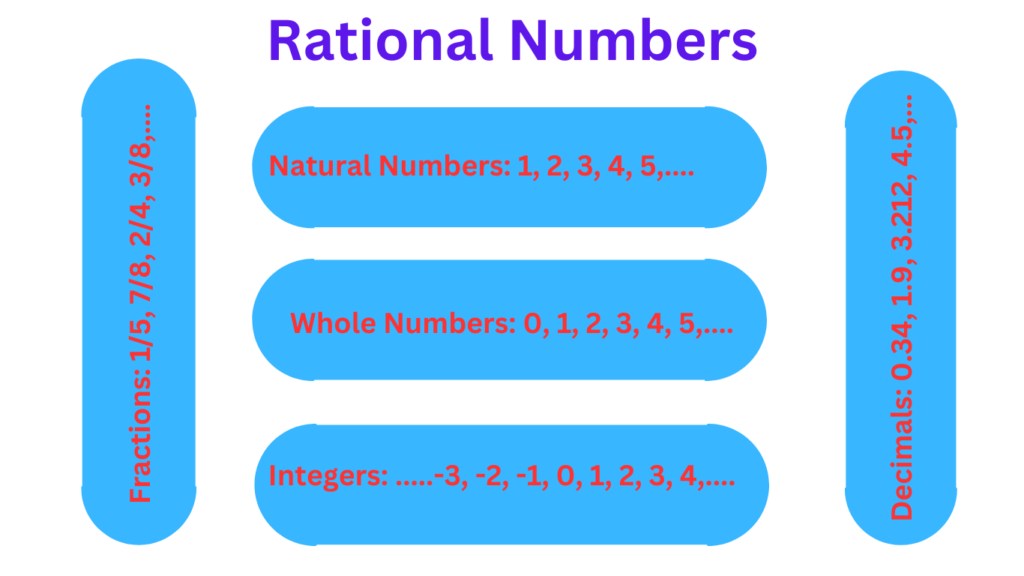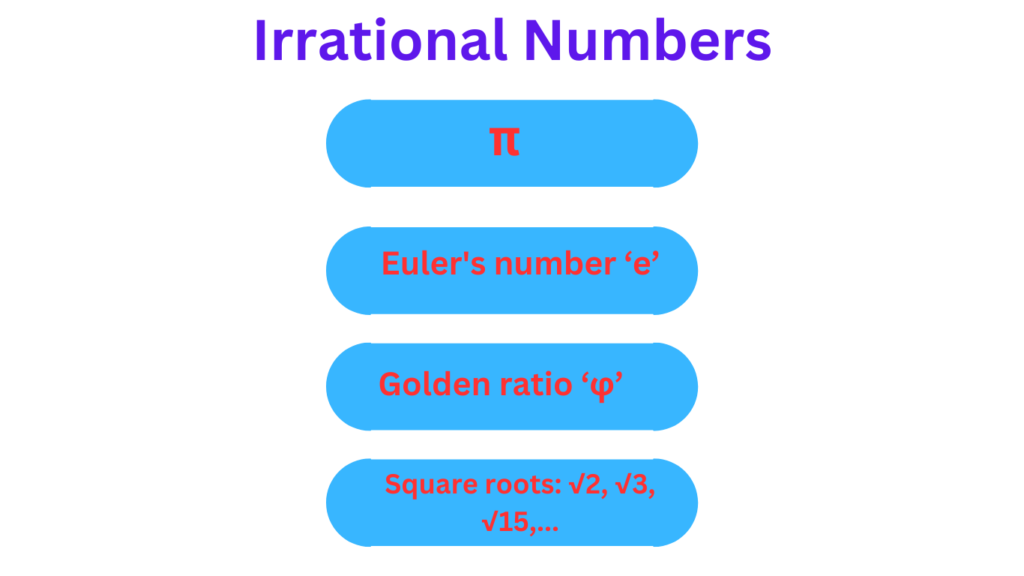Are Rational and Irrational Numbers Your Worst Nightmare? Don’t Freak Out. Through this article, we will make your worst nightmare a fun learning experience.
Numbers are the fundamental building blocks of mathematics, serving as a universal language that transcends cultural and linguistic barriers. From counting objects to measuring quantities, numbers permeate every aspect of our lives, shaping our understanding of the world around us. However, numbers’ sheer diversity and complexity necessitate classification into different types. So, in this article, we mainly dive into the two main categories of those classifications: rational and irrational numbers.
What are Rational Numbers?
Rational numbers are like the friendly, approachable folks at a party—they can be expressed as fractions and are quite accommodating. Defined as any number that can be written as the ratio of two integers (where the denominator is not zero), they include familiar faces like 3/4, -5/2, and even whole numbers like 7.
Imagine a delicious pie cut into eight equal slices. If you devour three whole slices, that’s a clear example of a whole number (3). But what if you crave a tiny sliver from the fourth slice? That sliver can be expressed as a fraction (¼). When we combine whole numbers and fractions, we enter the realm of rational numbers.

Here are some key characteristics of rational numbers:
- They can be positive (like ¾), negative (-½), whole number (1, 2, 3, ..) or even zero (0).
- They can be expressed as simple fractions (like 5/7) or mixed numbers (like 2 ¾).
- They can also be represented as terminating or repeating decimals (more on that later!).
Representing rational numbers on a number line is a breeze. Picture a line stretching infinitely in both directions, with neatly spaced points representing each rational number. For example, 1/2 would fall halfway between 0 and 1, while -3/4 would be positioned to the left of zero.
What are Irrational Numbers?
Now, let’s delve into the fascinating realm of irrational numbers. These numbers are like mathematical rebels – they cannot be expressed as a simple fraction (a/b, where b ≠ 0). No matter how hard you try to write them as a fraction, you’ll end up with an infinitely long decimal that never repeats in a predictable pattern.
Perhaps the most famous example of an irrational number is the never-ending decimal representation of pi (π), which signifies the ratio of a circle’s circumference to its diameter. No matter how many decimal places you calculate, pi (π) will continue to hold an endless string of digits that never repeats.

Another well-known irrational number is the square root of 2 (√2). Imagine a square where each side measures exactly one unit. The diagonal of this square, when measured, will not correspond to any whole number or fraction – its length is equal to √2, an irrational number.
So, why can’t we express these numbers as fractions? Here’s the gist: If you could represent an irrational number as a fraction (a/b), then multiplying both the numerator and denominator by the same number (say, b) would result in a whole number. However, this contradicts the very definition of √2 and pi (π) – they are not whole numbers, nor can they be expressed as a ratio of two whole numbers.
Relationship Between Rational and Irrational Numbers
Rational and irrational numbers might seem like separate entities, but they coexist harmoniously on the number line. The number line encompasses all rational numbers (both positive and negative) along with the sprinkling of irrational numbers that fill in the gaps. Together, they create a complete picture of the real number system.
Think of it like this: Imagine a ruler. The whole numbers are like the tick marks on the ruler, easy to identify and represent with fractions. But there are countless points in between these tick marks – those are the irrational numbers, filling the gaps and ensuring a continuous spectrum of values.
In the real world, we often encounter situations where both rational and irrational numbers come into play. For instance, calculating the area of a rectangle involves multiplying its length (which could be a rational number like 4 meters) by its width (which might be an irrational number like √2 meters).
Applications of Rational and Irrational Numbers
Rational and irrational numbers are not just abstract concepts; they play a vital role in various fields. Here are some captivating examples:
- Science: Physicists use rational numbers to describe forces, velocities, and accelerations. However, they rely on pi (π) to calculate the volume of spheres and the circumference of circles.
- Engineering: Architects employ rational numbers for precise measurements in building plans, while also using pi (π) to calculate the areas and volumes of cylindrical structures.
- Finance: Financial analysts utilize rational numbers for calculations involving interest rates, percentages, and ratios. However, irrational numbers like the irrational numbers like the golden ratio (φ) come into play when designing visually appealing financial charts and layouts.
Understanding both rational and irrational numbers is crucial for these professionals and many others.
Historical Perspective
The concept of rational and irrational numbers has a rich history. The ancient Greeks, known for their advancements in mathematics, first stumbled upon the idea of irrational numbers. They discovered the existence of √2 through the Pythagorean theorem, realizing that the diagonal of a square with side length 1 could not be expressed as a simple fraction. This discovery challenged their existing understanding of numbers and sparked further exploration.
Mathematicians like Euclid, a prominent figure in Greek mathematics, meticulously documented these concepts, laying the foundation for future generations. As centuries passed, mathematicians like Carl Friedrich Gauss in the 18th century made significant contributions to the theory of irrational numbers, proving the existence of transcendental numbers – a special subset of irrational numbers that cannot be expressed as the root of a polynomial equation with integer coefficients.
The exploration of rational and irrational numbers continues to this day. Mathematicians are constantly seeking new ways to understand and classify these fascinating numbers, pushing the boundaries of mathematical knowledge.
Challenges and Misconceptions
Many students (and even adults) grapple with understanding rational and irrational numbers. Here are some common misconceptions and how to overcome them:
- Misconception 1: Rational numbers are more “important” than irrational numbers.
Both rational and irrational numbers are essential for a comprehensive understanding of mathematics. While rational numbers are used more frequently in everyday calculations, irrational numbers play a crucial role in advanced mathematics, geometry, and physics.
- Misconception 2: Irrational numbers are infinite.
While irrational numbers have infinitely many decimal places that never repeat, they represent a specific value on the number line. They are not inherently infinite themselves.
- Misconception 3: Working with irrational numbers is complex.
While calculations involving irrational numbers can sometimes be more intricate, there are various techniques and tools available to simplify them. Often, approximations or rounded values of irrational numbers can be used for practical purposes.
Here are some tips to overcome these challenges:
- Visualize the concepts: Use number lines and diagrams to represent rational and irrational numbers, making them more tangible.
- Practice with examples: Solve problems that involve both rational and irrational numbers. This will solidify your understanding and build confidence.
- Seek help: Don’t hesitate to ask your teacher, a tutor, or a classmate for clarification if you encounter difficulties.
Fun Facts and Curiosities
The world of rational and irrational numbers holds a treasure trove of fascinating facts and surprising connections:
- The beauty of pi (π): The digits of pi (π) appear to be random, but mathematicians have discovered intriguing patterns within its seemingly endless sequence.
- Irrational music? Composers have experimented with using irrational number ratios to create unique and unexpected harmonies in music.
- Fractals and infinity: The intricate geometric patterns of fractals, often used in computer graphics, are based on the properties of irrational numbers and their relationship with self-similarity.
Exploring these fun facts can spark your curiosity and make learning about rational and irrational numbers even more engaging.
The Beauty of Mathematical Harmony
As we delve deeper into the world of rational and irrational numbers, a sense of awe emerges. These seemingly simple concepts reveal a hidden elegance and a profound interconnectedness within the vast realm of mathematics. Rational numbers provide a foundation for precise calculations, while irrational numbers add an element of infinity and intrigue. Together, they create a harmonious symphony, each note playing a vital role in the grand composition of mathematics.
Conclusion
This exploration of rational and irrational numbers has hopefully unveiled their unique characteristics and their significance in the fascinating world of mathematics. Remember, the journey of learning never ends. As you continue your studies, you’ll encounter even more captivating applications of these numbers across various disciplines. So, embrace the challenge, delve deeper, and appreciate the beauty and harmony that rational and irrational numbers bring to the world of mathematics, and perhaps, even to your everyday life.
Frequently Asked Questions (FAQs)
What are some real-life examples of rational and irrational numbers?
Real-life examples of rational numbers include measurements like measuring recipe ingredients, while irrational numbers like pi (π) is used in designing bike wheels.
How can I distinguish between rational and irrational numbers in decimal form?
We can distinguish between rational and irrational numbers in decimal form by knowing this simple trick: Rational numbers have terminating or repeating decimals (e.g., 0.75, 1.333…), while irrational numbers have infinitely long, non-repeating decimals (e.g., 3.14159…).
Are there any practical strategies for overcoming misconceptions about rational and irrational numbers?
Practical strategies for overcoming misconceptions about rational and irrational numbers include using visual aids, providing concrete examples, and engaging students in real-world problem-solving activities.